It is not unusual that guitarists put stickers on their guitars. Some stickers have a personal meaning. While Others are the guitarists’ expressions of interest (movies, favorite rock bands, games).
But, Is it safe to put stickers on a guitar? Or Should you? It is safe to put stickers on the instrument unless you cover the whole guitar with them.
Putting stickers on your guitar and personalizing it is great. But, before putting them on your instrument, it’s good to know where you can and where you shouldn’t, and in what circumstances.
Can You Put Stickers On An Acoustic/Electric Guitar?
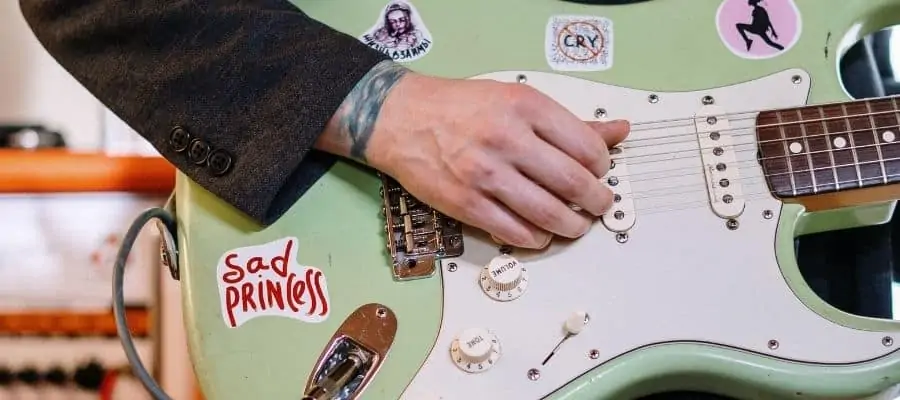
You can see that some guitar stars, such as Joan Jett, Tom Morello, and Billie Joe Armstrong, put stickers on their instruments. So yes, you can put stickers on your guitar and customize it to express your interests and affinities. It’s like putting your brand on it.
You can add a new, unique dash to the guitar by decorating the body and other guitar parts. It is something like a time-honored tradition, especially for punk guitarists like Tom Delonge, Benji Madden and Dexter Holland.
Does Putting Stickers On My Guitar Affect Its Sound?

Putting stickers on the guitar can affect the sound in a negative way. But, that difference is negligible to a human ear in most cases. Stickers affect the sound differently, depending on some factors.
Number Of Stickers
If you put a few stickers on your acoustic guitar, you will not detect any difference in the sound. On the other side, that guitar layered with plenty of them may sound different. The sound will be dull because of the layer over layers.
On the other hand, you can have much more stickers over the electric guitar’s body and still have the same sound because the body is not the most contributor to the guitar’s sound.
Location
Sticker layers will probably dampen the sound on an acoustic or classical guitar because the guitar’s top and back are like a vibrating membrane.
For example, guitar string vibrations cause soundboard vibration (and it is also transmitted to the side and back of the guitar) which causes the air vibration inside the guitar body. That air is going through the soundhole. If there is anything that affects the soundboard vibration, such as a thick, heavy sticker, the overall sound will be different. There, wood really needs to vibrate freely.
Therefore, the tonal difference is more significant on an acoustic guitar than on an electric guitar if you put the sticker on top because the tone of the electric guitar depends on the things such as pickups, scale length, and bridge.
So, stickers on an electric guitar are acceptable, unless they are on the fretboard, pickups, and bridge. But, according to Fender, you would need to amplify your guitar ten times higher than usual to detect the tonal difference on this guitar type.
Sticker Properties
If stickers are heavy and thick on your acoustic guitar, you will hear the tonal difference because changing the mass of the top will change the guitar sound. It’s because the mass change causes vibrations’ change. So, putting the lighter stickers on shouldn’t make a noticeable tonal difference.
Should You Put Stickers On Your Guitar?
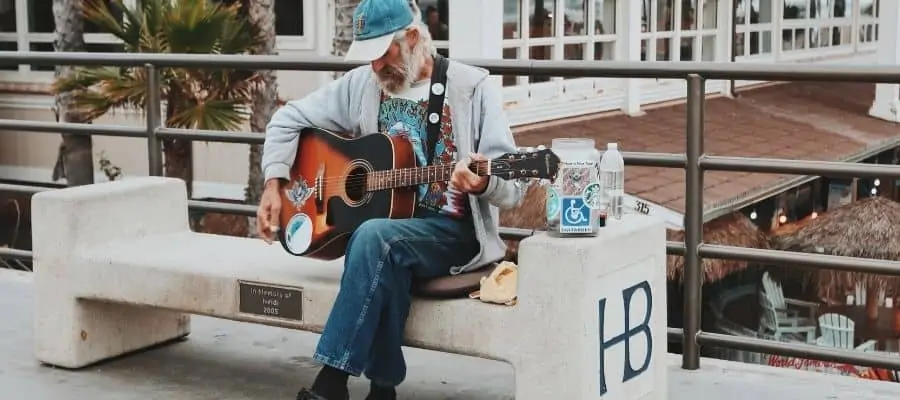
Different people have different opinions when it comes to putting stickers on instruments. And yes, it has its pros and cons, just like everything else.
Pros
Putting stickers on your guitar is like having your own guitar brand. Your guitar will not be just a Gibson LP – it will be your Gibson LP.
This will probably increase your motivation to practice and play more because you will feel a special connection because it’s just yours, and no one has the same. It’s unique. So, it’s a way of expressing your creativity. The guitar is a canvas, and stickers are colors – these two make serious art.
People love expressing their interests and affinities by having a phone case, T-shirt, tattoos, posters, and key chains with a favorite band, partner name, or maybe movie character on it. So, why not put it on the guitar also? You will love the guitar more, and gain a special connection because the guitar is now something that represents you, right along with the music you create, and it will start having a sentimental value to you.
The guitar appearance with the monotonous color and frets neutralized is more interesting, either for the player or the eyes of the audience during the show.
Old instruments may lose their shine and beauty. You can add a new life to the guitar by putting on stickers and letting it be more joyful. Also, stickers are a fantastic option for hiding scratches and color changes on particular guitar parts.
Cons
It is easy to put stickers on the guitar, but the problem is removing them when they get boring to you. The removing process can be pretty hard, especially if the sticker’s glue strength is on a high level. It can leave residues underneath the sticker that’s so hard to remove, so the removing process will destroy your guitar finish, especially if you use the wrong solvent.
Some people say they have discovered the ruined guitar finish even before trying to scrape residues away.
More precisely, it is not the main problem to remove stickers – the problem is how to do it without damaging the guitar. If you do any damage, there is a chance of damage spreading. It’s like a chain reaction.
Also, the aging color process on the guitar becomes quite unbalanced. The color underneath the sticker is protected from aging. Therefore, if you decide to remove the sticker, that region where the sticker was will be lighter and less yellowed than the rest of the guitar that was going through the naturally-aging process. You can slow down the whole aging color process by storing your guitar adequately and away from the sun rays, but you can’t stop it.
And it’s important to know that this process on electric guitars is more frequent on those with the nitro finish. Poly finishes can remain the same after decades of use.
If you have a slice of history in your guitar collection, you have to know that the number of years is what makes the guitar special. So, there is no need for adding a new life to the guitar by adding stickers or making the guitar unique because it already is.
Putting stickers on the guitar, especially on those that have a historical value, will affect the resale value. Pawnshops, most of the time, refuse to buy them. Imagine buying a guitar covered with a music star you can’t stand or someone else’s partner’s name, and it’s not your wife/husband’s name.
Where Should I Put A Sticker On My Guitar?

Before putting stickers on your instrument, you should consider the guitar type. As I said, acoustic guitars are more likely to sound different with stickers on the top of the guitar because stickers will dull the vibrations where wood needs to vibrate freely to produce an adequate sound.
So, putting stickers on the top of an acoustic guitar is not recommended. When it comes to the electric guitar, I suggest not to put stickers on pickups, for example.
Therefore, putting stickers on the guitar back is a good option. It will not affect the sound, and you will not be scared to ruin the front guitar finish. Also, it’s less visible, and it’s like a secret between you and your guitar.
Stickers on the front of a guitar body are popular. You can stick them in the corner of your guitar body. For acoustic guitars, the bottom corner is preferred. I recommend you keep it minimal.
A headstock, as a sticker location, is also popular. For many guitarists, it’s probably the best place for a sticker.
Often, guitarists put stickers on a fretboard to neutralize the monotonous frets’ appearance. They will last longer on an acoustic guitar fretboard because you don’t play slides and bends that much, so they will not scratch off soon.
Can I Put Stickers On My Fretboard And Are They Useful?
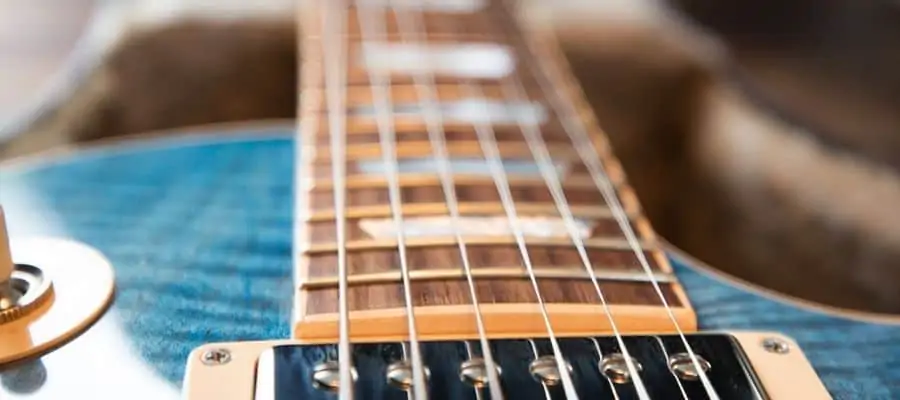
Yes, it is possible to put stickers on the fretboard. It takes more time than putting them on a guitar body, for example, because you have to take strings off first.
A significant number of guitarists put decorations on the fretboard because they want them to look more joyful, or they want their fretboard to look more expensive. Many of them use fretboard stickers for easy scale notes identification. I wouldn’t recommend doing so.
You might get used to looking at the labels and end up not learning the notes but just spotting stickers. If you need markings, they are already there, and they will help you with all scales.
Putting markings on the fretboard can also damage the fretboard wood. Lacquered fretboards should be marked with non-residue temporary tape, just as the rosewood or ebony fretboards. It is crucial not to use plastic-based stickers, vinyl, or duct tape because they tend to be permanent. In that way, you may damage and discolor the wood because you don’t want people to see those stickers when you become a serious player.
Instead of this learning option, try to print some diagrams. Look at them and transfer what you see on the fretboard, and then throw them away and play some notes by feel. Guitar stickers are always there during your practice. They will encourage you to look at the instrument constantly, which is not okay for your improvement.
Are Vinyl Stickers Safe To Put On The Nitro Finish?
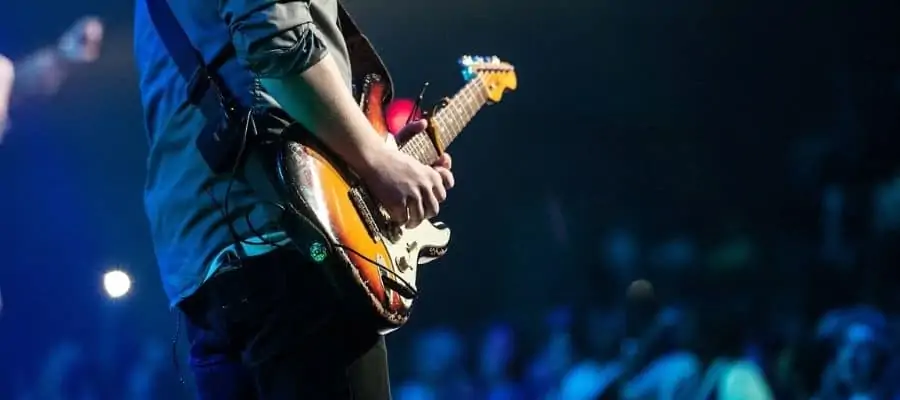
Stickers can destroy the guitar finish, and the possibility for them to ruin the finish depends on the finish itself and the type of sticker.
For example, putting vinyl stickers on the poly finish will not ruin the finish. On the other side, nitro finishes are more likely to be destroyed from vinyl stickers because they interact with the sticker glue. The glue seeps into the nitro and discolors or damages it (the finish will start to bubble).
How Do I Get Stickers Off My Guitar?

People come up with many stickers removing methods, and it can be pretty easy if you have proper tools.
You can get stickers off the guitar by rubbing it with alcohol, water, or acetone, but not any of them. Some of the stickers have such a stubborn adhesive. So, it’s good to find a sticker removal liquid. You will need some gloves on and eye protection. Also, you need to prepare a paper or a microfiber towel and guitar polish.
I recommend you to test the liquid on your guitar finish (on the back if possible – if something happens, it will not be that noticeable) to make sure it will not mars it.
After that, pour a small amount of a sticker removal liquid onto the sticker. Scrape at the sticker with the pick. Liquid can dissolve the pick material and discolor the guitar paint, so be sure the pick and guitar color match, or try with any other material that is not that sharp to harm the finish. Apply more liquid if the sticker is not off, and remove the residue. Clean the area with a paper towel and polish the guitar.
If you don’t have access to the adhesive removal, try with sprays, wipe removers, soy-based removers, or solvents. Solvents have the highest risk of damaging the finish.
Removing stickers off the fretboard is a bit different. You also may need a string winder and a long thread. Take the thread and tie a loop in one end so you can tie back guitar strings. Loosen the strings’ tension by hand or with a string winder. After that, you can pull them right and left to have sticker access. If you want to change strings also, take them off, and start the removing process.
Many guitarists recommend using a blow dryer to heat stickers and loosen the adhesive. Don’t overheat because the plastic may warp.
Top 3 Adhesive Remove That Is Safe For The Guitar

Adhesive removals take off residues made from oil, grease, glue, and so on. People use them if it’s difficult to remove residues with standard cleaners, such as water or alcohol. Guitarists use it to take stickers off the guitar.
Keep in mind that adhesive removals are effective and usually safe for your guitar, but there is a chance for damage. That’s why it’s crucial to test the liquid on a guitar finish to see how it reacts. If everything is okay, you can process removing stickers.
There are top 3 adhesive removals that guitarists mention in the most positive way.
Goo Gone Original Liquid
- Safely Restore Your Surfaces - The surface-safe formula removes the goo...
- Trusted #1 Brand For Removing Gooey Messes – Try it on stickers, wax,...
- Multiple Uses Around The House – Everything from wine glass label...
- Great For Teachers and Parents - Use this to remove gum, tape, crayon and...
Goo Gone is a citrus-based product for taking off residues leftover from pricing labels, crayons, stickers, glue, and glitter. They are safe for most surfaces. Goo Gone is an adequate solution for residues stubborn for other techniques. From their experience, guitarists say it’s safe for nitro and poly finishes.
Naphtha
- Bundle includes 2 VM&P NAPTHA QT by KLEAN-STRIP
- Bundle includes 2 VM&P NAPTHA QT by Klean-strip
Naphtha is safe on pretty much all guitar parts and finishes and evaporates in a couple of minutes. It’s one of the safest solvents you can use. It’s for the removal of some heavy, sticky residue, such as sticker glue. Guitarists say it is non-reactive with most nitro and poly finishes. “Naphtha… It’s what pros use. Safe for all finishes, including nitrocellulose”, wrote one guitarist.
WD-40
- DRIVES OUT MOISTURE: Drives out moisture and quickly dries out electrical...
- CORROSION INHIBITOR: Acts as a corrosion inhibitor to shield against...
- FREES AND LOOSENS STICKY PARTS: Frees sticky mechanisms, loosens...
- Gets under grease, grime, gunk, gum, tar, sap, super glue, sticker residue,...
WD-40 is excellent in removing the sticker adhesive off the guitar. It is non-reactive with most nitro and poly finishes. “WD40 works great! I purchased a guitar that had stickers on it for years, and they came right off the nitro finish and pickguard without any problems. “, said one guitarist.
Conclusion
You can buy guitar stickers in any music shop or even get them as an order gift. Many people love putting stickers on the guitar because it is a way of expressing themselves. They show their interests and affinities to the world, just like some people wear T-shirts with a favorite music star on them.
But, there is a negative side to putting stickers on guitars – it can affect the sound. But, experts say it is negligible unless you cover the whole guitar with them. Affecting the sound depends on some factors. Stickers may dull the vibrations that are crucial for sound-producing when it comes to the acoustic or classical guitar. Heavy and thick stickers on electric guitar pickups, for example. That will probably affect the sound. But, as I said, the difference is not perceptible for human ears in most cases.
There are both pros and cons to putting stickers on the guitar. You should put stickers because they present who you are. Also, a guitar with stickers is a unique one. Also, you can hide some scratches on your guitar with them. Besides that, you can make an old guitar more joyful and add a new life to it.
But, stickers are hard to remove, and the removal process can destroy the guitar finish. Also, a resale value will go down.
So, if you want to put stickers on the guitar, think about the one question: “Do I want to have it forever?” If yes, then go for it!
If you found this article useful, you may want to save this pin below to your Guitar board.
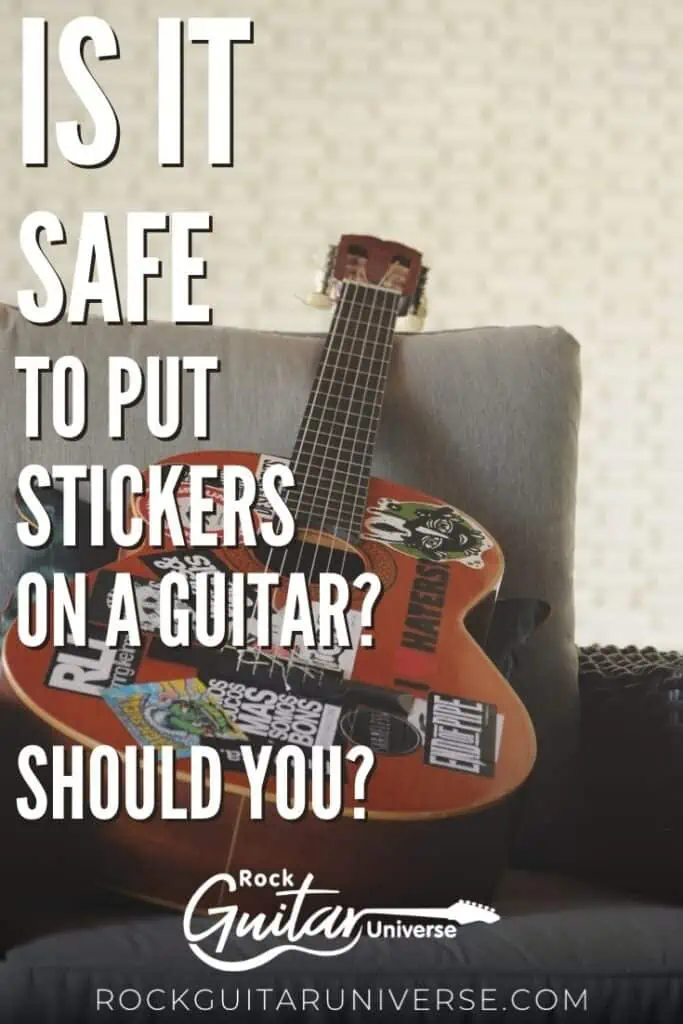
Last update on 2026-01-07 / Affiliate links / Images from Amazon Product Advertising API
2 thoughts on “Is It Safe To Put Stickers On A Guitar? Should You?”
Leave a Reply
Recent Posts
When learning new songs have you noticed that some of the chord sequences sound really good? But when you tried to come up with your own chord sequence, or as we call it chord progression, you found...
Some guitarists insist on buying an expensive amplifier with their electric guitar. They assume that this is a must for every type of guitarist out there. However, in some situations, this isn’t...

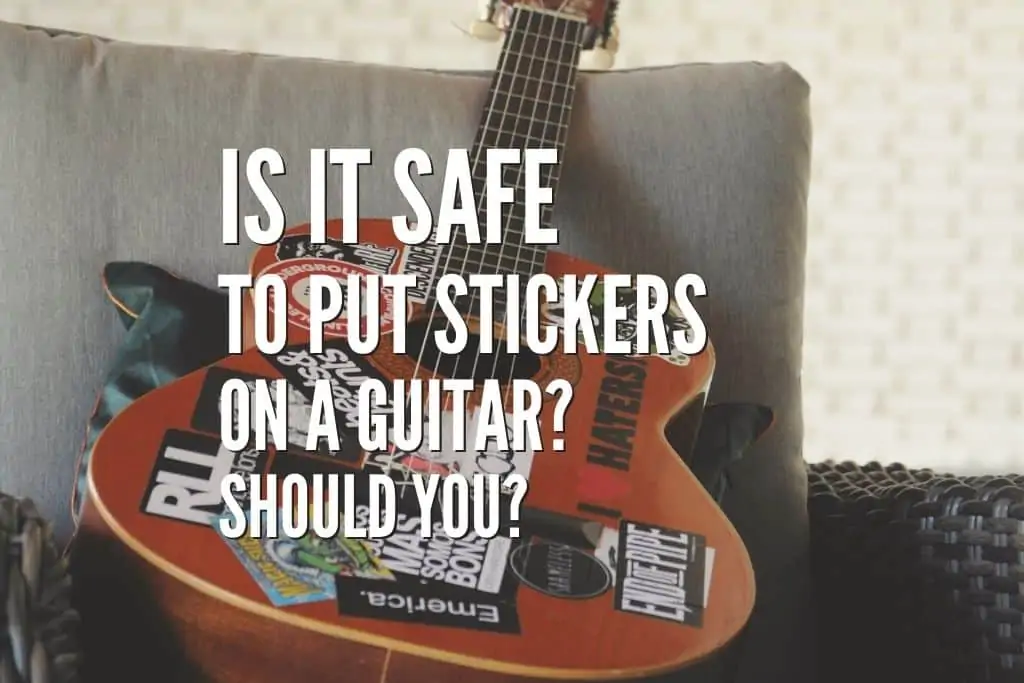
Do you have to buy specific stickers for guitars or can any sticker be used?
you can use any stickers you like